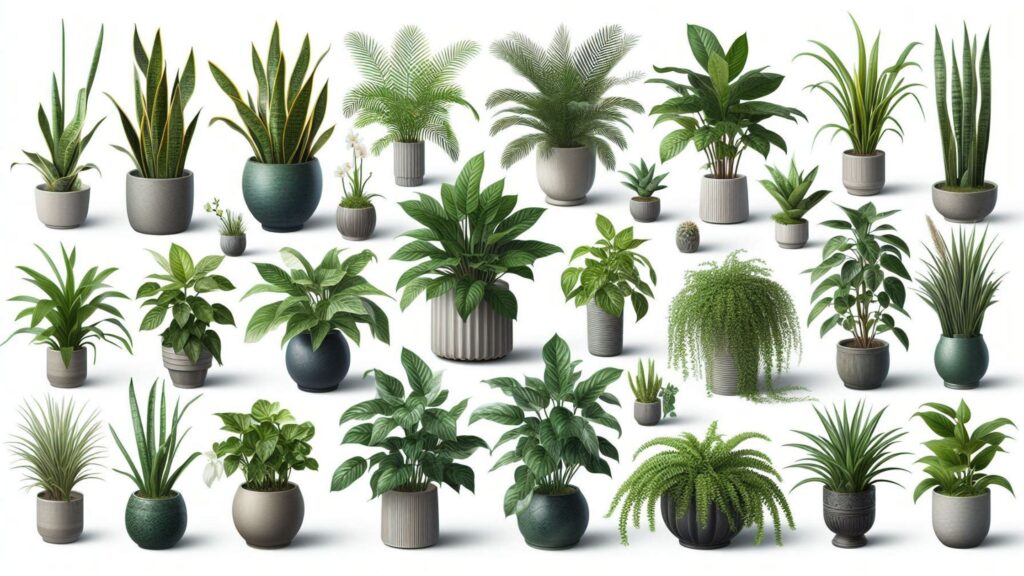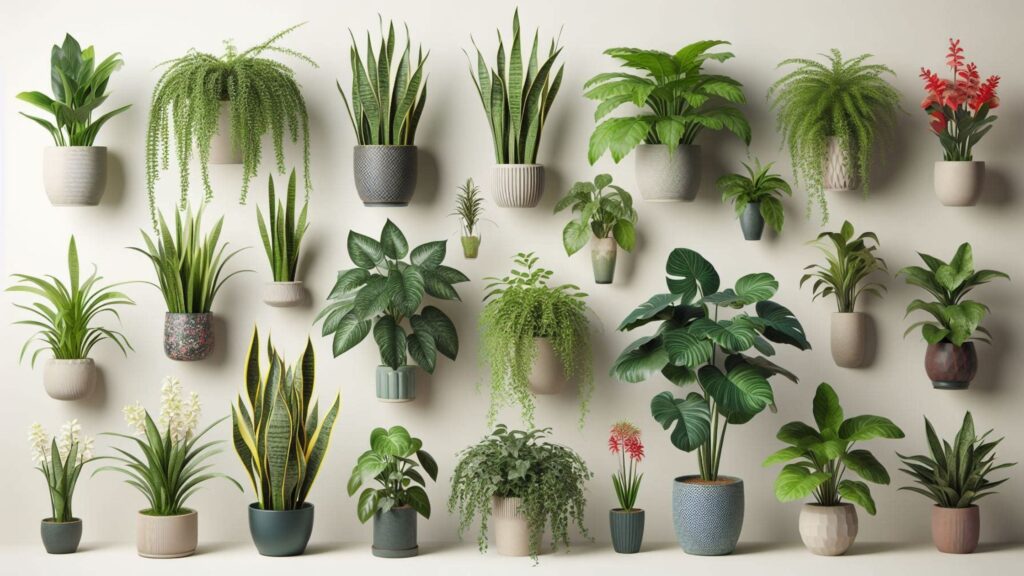Air-purifying indoor plants are an invaluable addition to any living or working space, offering not just aesthetic enhancement but also significant health benefits.
Types of Air Purifying Indoor Plants
- Snake Plant
- Spider Plant
- Peace Lily
- Boston Fern
- Aloe Vera
- Rubber Plant
- Dracaena
- Philodendron
- English Ivy
- Chinese Evergreen
Air Purifying Indoor Plants
Sansevieria trifasciata, or Snake Plant: The snake plant has gorgeous straight leaves with distinct colored stripes. It is highly durable and may thrive well in low light. Formaldehyde, benzene, the presence of x, and trichloroethylene are just some of the dangerous substances that it may filter out.
Spider Plant (Chlorophytum comosum): The spider plant is a lovely addition to any area since its leaves rise and are covered in small white flowers and spiderlets. It’s effective in removing pollutants such as formaldehyde and xylene.
Peace Lily (Spathiphyllum spp.): People appreciate the peace lily’s lovely white blossoms and lush green foliage. Toxins including ammonia, formaldehyde, benzene, and trichloroethylene may be removed out of the air with it, which is why many people pick its beds and living rooms.
Boston Fern (Nephrolepis exaltata): Boston ferns are admired for their delicate fronds that fall gently, bringing a hint of greenery to interior regions. They’re successful in removing pollutants like formaldehyde and xylene.
Aloe Vera (Aloe barbadensis miller): Besides its medical benefits, aloe vera is also a great air purifier. There are dangerous compounds in indoor air that this plant helps get rid of. It also gives your property a tropical atmosphere.
Rubber Plant (Ficus elastica): This plant makes a powerful impression in any space with its huge, lustrous leaves. It works effectively in bright, indirect light to get rid of formaldehyde from indoor air.
Philodendron (Philodendron spp.): Philodendrons are recognized for their lush foliage and simple maintenance demands. They’re good at filtering out formaldehyde from the air and come in many varieties, including heartleaf, selloum, and Swiss cheese plants.
Dracaena (Dracaena spp.): Dracaenas are multipurpose plants available in diverse shapes, sizes, and colors. They’re efficient in eliminating contaminants including formaldehyde, benzene, and trichloroethylene from indoor air.
English Ivy (Hedera helix): English ivy is a typical vine noted for its capacity to clear the air by lowering airborne mold and fecal matter particles. It’s ideal for hanging baskets or as a growing plant on shelves.
Chinese Evergreen (Aglaonema spp.): Chinese evergreens are regarded for their lovely foliage and tolerance to low light settings. They’re successful in clearing pollutants like benzene and formaldehyde from indoor air.

Benefits of Indoor Plants
Here are the benefits of each plant using simple sentences with the correct articles:
Snake Plant Benefits:
- The snake plant improves indoor air quality by filtering out toxins.
- It requires minimal care and can thrive in low-light conditions.
- The plant also releases oxygen at night, promoting better sleep.
Spider Plant Benefits:
- Spider plants are excellent at removing harmful pollutants from the air.
- They are easy to grow and maintain, making them perfect for beginners.
- The plant also reproduces quickly, filling your space with greenery.
Peace Lily Benefits:
- The peace lily is known for its ability to purify the air by absorbing toxins.
- It adds a touch of elegance to any room with its white flowers.
- The plant is also low-maintenance and can thrive in low-light environments.
Boston Fern Benefits:
- The Boston Fern is a natural air humidifier, adds moisture to indoor spaces.
- It is effective at removing pollutants like formaldehyde and xylene from the air.
- The plant’s lush foliage creates a calming atmosphere in any room.
Aloe Vera Benefits:
- Aloe vera has soothing properties and can be used to treat minor burns and cuts.
- It is easy to grow indoors and requires minimal watering.
- The plant also purifies the air by removing toxins like benzene and formaldehyde.
Rubber Plant Benefits:
- The rubber plant is effective at removing indoor air pollutants.
- It is a low-maintenance plant that can tolerate low-light conditions.
- The plant’s large, glossy leaves add a touch of tropical elegance to any space.
Dracaena Benefits:
- Dracaena plants are known for their air-purifying abilities, removing toxins from the environment.
- They come in various shapes and sizes, making them versatile for different spaces.
- The plant is also easy to care for, requiring minimal attention to thrive.
Philodendron Benefits:
- Philodendrons are excellent at purifying indoor air by absorbing harmful chemicals.
- They are easy to care for and can tolerate low-light conditions.
- The plant’s trailing vines add a decorative touch to shelves and hanging baskets.
English Ivy Benefits:
- English ivy is effective at reducing airborne mold and mildew particles.
- It is a versatile plant that can be grown indoors or outdoors.
- The plant’s cascading foliage adds a charming aesthetic to any space
Chinese Evergreen Benefits:
- Chinese evergreens are known for their ability to purify indoor air.
- They are resilient plants that can thrive in low-light conditions.
- The plant’s attractive foliage adds beauty to homes and offices alike.
FAQ Of Air Purifying Indoor Plants
1. What are indoor plants that filter the air?
Ans: By eliminating toxins and releasing oxygen, these plants purify the air within your house.
2. These plants purify the air in what way?
Ans: Through photosynthesis, they convert the poisons they take into oxygen by means of their roots and leaves.
3. Are these plants particularly cared for?
Ans: Although some require pruning, sunshine, and water, most are low maintenance.
4. What number do I need?
Ans: That depends on how big and how polluted your house is. Aim for one plant per 100 square feet as a starting point.
5. Are they able to improve my health?
Ans: A cleaner air quality can, in fact, improve breathing and reduce allergy symptoms.
6. Are they secure around children and pets?
Ans: The majority are harmless, but some, if consumed, may be toxic. Verify whether they are safe for your children and pet animals.






My brother recommended I would possibly like this blog. He was totally right. This put up truly made my day. You cann’t consider just how so much time I had spent for this information! Thanks!
This is some awesome thinking. Would you be interested to learn more? Come to see my website at FQ5 for content about Thai-Massage.